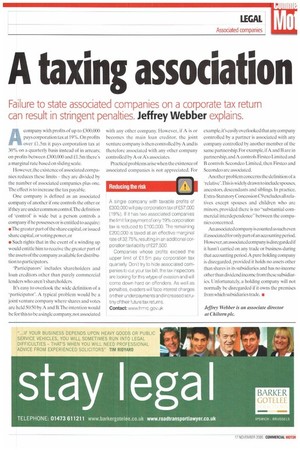A taxing association
Page 41

If you've noticed an error in this article please click here to report it so we can fix it.
Failure to state associated companies on a corporate tax return
can result in stringent penalties. Jeffrey Webber explains.
Acompany with profits of up to 000,000 pays corporation tax at 19%.0n profits over il .5in it pays corporation tax at 30% on a quarterly basis instead of in arrears; on profits between £300,000 and £1.5m there's a marginal rate based on sliding scale.
However, the existence of associated companies reduces these limits — they are divided by the number of associated companies plus one. The effect is to increase the tax payable.
One company is defined as an associated company of another if one controls the other or if they are under common control.The definition of 'control' is wide but a person controls a company if he possesses or is entitled to acquire: e rThe greater part of the share capital,or issued share capital, or voting power, or
• Such rights that in the event of a winding up would entitle him to receive the greater part of the assets of the company available for distribution to participators.
'Participators' includes shareholders and loan creditors other than purely commercial lenders who aren't shareholders.
Ifs easy to overlook the wide definition of a 'participator'. A typical problem would be a joint venture company where shares and votes are held 50/50 by A and B.The intention would be for this to be a single company, not associated with any other company. However, if A is or becomes the main loan creditor, the joint venture company is then controlled by A and is therefore associated with any other company controlled by A or As associates.
Practical problems arise when the existence of associated companies is not appreciated. For
Reducing the risk A single company with taxable prof its of 2300,000 will pay corporation tax of £57,000 (19%). If it has two associated companies the limit for payment of only 19% corporation tax is reduced to 2100,000. The remaining £200,000 is taxed at an effective marginal rate of 32.75%,resulting in an additional corporation taxliability of 227,500.
Companies whose profits exceed the upper limit of 21.5m pay corporation tax quarterly. Don't try to hide associated companies to cut your tax bill the tax inspectors are looking for this wtype of evasion and will come down hard on offenders. As well as penalties, evaders will face interest charges on their underpayments and increased scrutiny of their future tax returns.
Contact: www.hmrc.gov.uk
exarnple,it'seasily overlooked that anycompany controlled by a partner is associated with any company controlled by another member of the same partnership. For example, if A and B are in partnership, and A controls Firstco Limited and B controls Secondtx) Limited, then Firstco and Secondco are associated.
Another problem concerns the definition of a 'relative'.1 his is widely drawn to include spouses, ancestors, descendants and siblings. In practice, Extra-Statutory Concession C9 excludes all relatives except spouses and children who are minors, provided there is no "substantial commercial interdependence" between the companies concerned.
An associated com pany is counted as such even if associ ated for only part of an accounting period. Howevcr,an associated company is disregarded if it hasn't carried on any trade or business during that accounting period.A pure holding company is disregarded, provided it holds no assets other than shares in its subsidiaries and has no income other than dividend income from these subsidiaries. Unfortunately, a holding company will not normally be disregarded if it owns the premises from which subsidiaries trade. •






































































































































































































